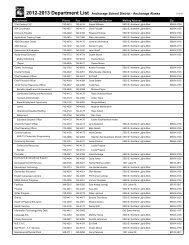You also want an ePaper? Increase the reach of your titles
YUMPU automatically turns print PDFs into web optimized ePapers that Google loves.
Astronomy Name _____________________________<br />
<strong>Lecture</strong>-<strong>Tutorial</strong> <strong>Parallax</strong>, <strong>Part</strong> 2<br />
<strong>Part</strong> 1: Parsec<br />
1. Consider the diagram to the right.<br />
a. Starting from Earth in January, Distant Stars<br />
Draw a line through star A to the<br />
line under your name above.<br />
b. There is now a narrow triangle with<br />
the Earth-Sun distance as its base.<br />
The small angle, just below star A,<br />
formed by the two longest sides of<br />
this triangle, is called the parallax<br />
angle for star A. Label it PA .<br />
SO WHAT??<br />
Knowing a star’s parallax angle allows us to calculate<br />
the distance to the star. Since even the nearest stars are Star A<br />
still very far away, parallax angles are extremely small.<br />
These parallax angles are measured in arcseconds where<br />
an arcsecond is 1/3600 of one degree.<br />
What is a PARSEC?<br />
To describe the distances to stars, astronomers use a unit<br />
of length called the parsec. One parsec is defined as the<br />
distance to a star that has a parallax angle of one arcsecond.<br />
The distance from the Sun to a star 1 parsec away is<br />
206,265 times the Earth-Sun distance, or 206,265 AU.<br />
2. If the parallax angle PA (for Star A) is 1 arcsecond,<br />
what is the distance from the Sun to Star A? Label this<br />
distance on the diagram!<br />
3. Is a parsec a unit of length or a unit of angle? It<br />
can't be both!<br />
4. Consider 2 stars that both exhibit parallax. If Star C<br />
appears to move back and forth by a greater amount<br />
than Star D, that is, Star C has a greater parallax,<br />
which star is closer?<br />
Note: Since he distance from the Sun to even the closest<br />
star is so much greater than 1 AU, we can consider the<br />
the distance from Earth to a star and the distance from the<br />
Sun to that star to be about equal.<br />
SUN<br />
Earth (Jan.) Earth (July)
<strong>Part</strong> 2: Distances<br />
On the diagram in <strong>Part</strong> 1, draw a second star on the dashed line farther from the Sun than Star A.<br />
Do this in another color or style (dotted line?), and label it Star B. Repeat steps 1a and 1b, and<br />
label the parallax angle PB .<br />
Questions:<br />
1. Which star, A or B, has the larger parallax angle?<br />
2. Consider the following discussion between two students working on this tutorial.<br />
Student 1: If the distance from the star is more than 1 parsec, then the parallax angle<br />
must be more than 1 arcsecond. Larger distance means larger angle.<br />
Student 2: If we drew a diagram for a star that was much more than 1 parsec away<br />
from us, the triangle in the diagram would be pointer (have a smaller parallax angle)<br />
than the one we drew in <strong>Part</strong> 1.<br />
Do you agree with student 1 or student 2, or neither? WHY????<br />
Summing Up:<br />
1. The two factors that affect the size of a parallax angle are:<br />
a.<br />
b.<br />
Fill in the following using the words increases or decreases<br />
2. Increasing the distance of an object, _____________ the parallax.<br />
3. Increasing the baseline, _____________ the parallax.
















